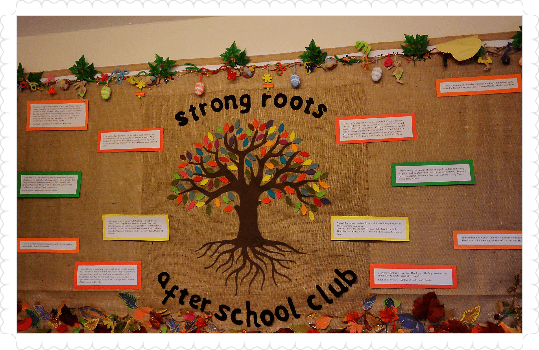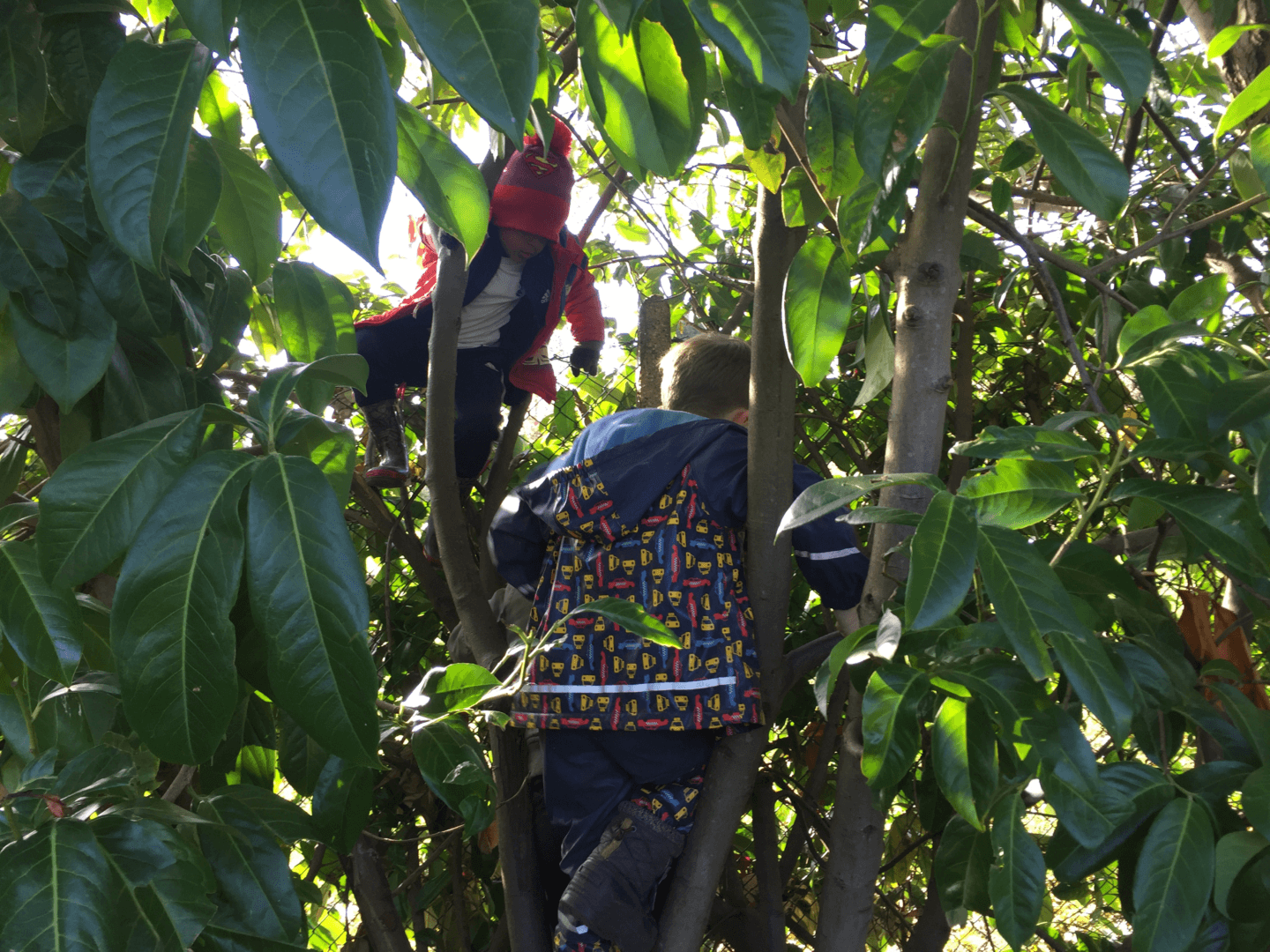Last week we visited a very unique after class club called ‘strong roots’. There are many of this kind of after school club in Britain. What is behind the name ‘strong roots’ after school club? We interviewed Suzanne who leads the club and she gave us a surprising yet delightful answer.
The original inspiration for ‘strong roots’ came from Suzanne’s own experiences of seeing children’s paintings and how these were a vehicle for self-expression. She decided on the name after seeing how the children thrived when involved with nature.

Does your nursery have a display wall (like the one shown above) to describe your “vision and ideas”?
Involving the children in nature the teacher acts only as a guide and the children are given space to freely express their imagination and creativity and to enjoy the aesthetics and magic of nature. In this way it reflects the philosophy of the learning centre’s director – let nature act as the best teacher for the children.
Part of understanding the world

During our visit the staff placed two snails in warm, humid containers and allowed children to become familiar with them and observe their growth. Once the snails had been fed the children are only too eager to tell me what they know about the snails, what they are doing and why snails inhabit the environment that they do.
When a snail enters the model castle (pictured below) Suzanne poses guided questions: “What is this?”she asks. A little boy replies: “This is a snail leaving behind traces…”.
Children are encouraged to understand and learn about these fascinating animals through close observation. This is one of the principles of good EYFS practice known as ‘Planning in the moment’. This refers to the process (where no advanced planning is required) whereby a teacher builds on what the child is already doing at that moment and only intervenes to help move their learning forward. These ‘teachable moments’ simultaneously engage children’s curiosity, encourage them to think further and allow them to give short but crucial timely responses to their interests.
1. Movement Skills
Using the educational framework of the seven areas of physical development laid out in EYFS, the nursery has a purpose-built and stable climbing frame with a see-saw to develop children’s sports and coordination. Climbing up and down the equipment lets children gain crucial balancing and dexterity skills. It is important to use a variety of artificial equipment together with natural resources to enable children to exercise confidently in various ways. In this way children learn to use space safely. Teachers may want to allow older children to climb trees to certain heights to enjoy sensory exploration of trees through touching and feeling in the fresh air and sunshine.

2. Physical health and self-care ability
We learnt that children gradually become aware of the importance of safe usage of devices and tools between the ages of 30 and 50 months in their development. Teachers also start to work on strengthening children’s physical movement and ability during this period so that they can learn to grasp tools and different objects safely and thus steadily improve these skills. They then use these tools when undertaking creative activities.
Exploration and use of media & Materials
Children can make the most of nature – even fallen leaves can become their musical instruments. For them the sound created by blowing grass leaves sounds on occasion, like pigs or like birds, is great fun.* Teachers resourcefully use the shell cuttings of hazelnuts, on the same sound principle as a flute, to teach children how to use airflow to produce a crisp and pleasant sounds.
Featured independent outdoor game
1. Mud kitchen
Let children have full play using their imagination.
Experience the real fun of cooking.
Develop a sense of cooperation and build partnerships.
Exercise small muscles to promote hand-foot co-ordination.
Teachers use natural resources such as soil to stimulate children’s imagination. This practice also promotes the principle of environmental protectionism. Some children tell me “I’m making magic potions.” Others tell me “I’m making a magic salad.” What a lovely and imaginative group!
2. Expedition
Fosters the children’s spirit of adventure, discovery and promotes their exploring capabilities.

At one point a young boy tells me excitedly, “Look, this is my base!”. So, when they are given a certain degree of freedom children become very good at discovering the secrets of nature. They learn to observe and feel by exploring and the nursery provides ample space to stimulate children’s curiosity and go exploring by themselves.
What kind of environment?
Provide an interactive environment.
Design an exhibition area of children’s work for display.
Create an open but secure environment.
Use widely available natural materials.
Allow children free access to all materials.
Real natural materials, safety conscious activities, being mindful of environmental protection.
Low cost, easy to collect multiple-use resources.
Stimulate children’s creativity and imagination.
Keep material fresh and stimulate children’s desire to explore.
Here most of the materials used have come from the natural environment and the children use their creative imaginations to inhabit fairy tale kingdoms with their teachers working as their guides. The club teachers are committed to being watchful guardians by simple observation and patience responding to the children’s needs where necessary. They respect the uniqueness of each child, explore ways to establish positive relationships between children and strive to create an interactive and open environment for them. They implement numerous independent outdoor games to achieve core EYFS concepts. We encourage you to create your own natural paradise of play and learning, growth and progress in your nurserie








